|
Spitfire Data |

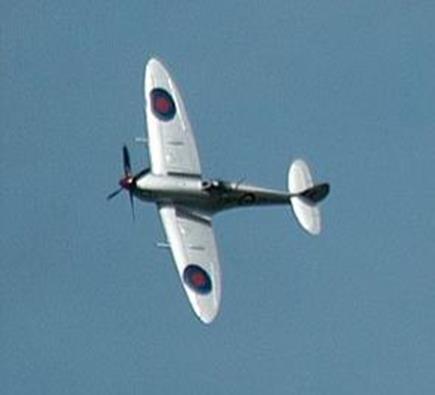




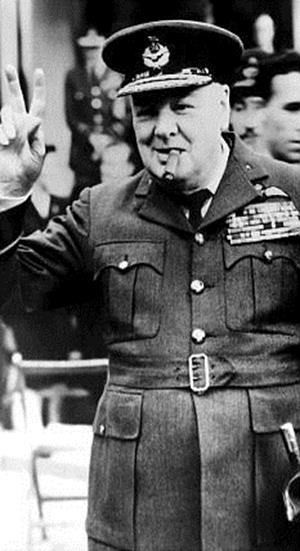





|
Aeroplane and Armament Experimental Establishment
Spitfire IX JL.165
SUMMARY Performance trials and a brief assessment of handling characteristics have been completed on a standard Spitfire IX with Merlin 66 engine, adjusted for maximum boost of +25 lb/sq.inch. 150 grade fuel to Specification RDE/F/253 was used through all tests. Engine conditions - 3000 rpm + 25 lb/sq.in. boost.
Climbs Max. rate of climb in M.S. gear (radiator flaps open) 5080 ft/min up to 500 ft Max. rate of climb in F.S. gear (radiator flaps open) 4335 ft/min up to 11,400 ft Max. rate of climb in F.S. gear (radiator flaps shut) 4750 ft/min up to 11,400 ft Estimated increase in rate of climb below full throttle heights 950 ft/min due to increase in boost from +18 to +25 lb/sq.in.
Level speeds Max. true air speed in M.S. gear 364 m.p.h. at 2,800 ft Max. true air speed in F.S. gear 389 m.p.h. at 13,800 ft Estimated increase in speed below full throttle heights 30 m.p.h due to increase in boost from +18 to +25 lb/sq.in.
Conclusions The increase in performance with the increase in boost from +18 to +25 lb/sq.in. corresponds to : 1) 950 ft/min. in rate of climb in M.S. gear There is also an increase in fuel consumption of approximately 24%. No maintenance difficulties of the engine were experienced.
|
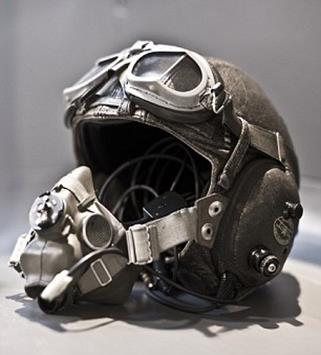
|
Aeroplane and Armament Experimental Establishment
Spitfire LF Mk. IX MA.648
Max. speed at F.T. height (9,400 ft.) in M.S. gear = 379 mph Max. speed at F.T. height (21,000 ft.) in F.S. gear = 411 mph
SUMMARY
.A Rolls Royce S.U. fuel injection pump, Mark II has been fitted to Spitfire LF Mk.IX MA.648 in place of the normal Bendix carburettor and level speed performance has been measured as part of the general schedule of tests including fuel consumption and behaviour under negative 'g'.
The principal results at combat conditions (i.e. 3000 rpm and +18 lb/sq.in. boost) are as follows:- These results compare favorably with those of other Spitfire LF Mk. IX aircraft, which fact is attributed chiefly to the higher full throttle height obtained with the S.U. pump. |
|
Air Ministry, A.I.2.(g). Whitehall
Spitfire IX v. German Fighters Spitfire IX
..................Engine Merlin 61. ..................Armament 2 x 20 mm. and 4 x .303" MG's. Max. speeds: At present engine rating (+15 lb. per sq. inch boost and 3,000 r.p.m.): 380 m.p.h. at 15,000 ft. 405 m.p.h. at 28,000 ft. 394 m.p.h. at 30,000 ft.
New aircraft coming into service will be fitted with re-rated engines operating at + 18 lb. per sq. inch boost and 3,000 r.p.m. The maximum speeds will be increased as follows: 385 m.p.h. at 15,000 ft. 409 m.p.h. at 28,000 ft. 394 m.p.h. at 30,000 ft.
Rate of climb at 20,000 ft: ..................The rate of climb varies according to type of reduction gear fitted. ..................With an 0.42 reduction gear (at + 15 lb. per sq.inch boost) the rate of climb is 2,540 per minute. ..................With the same reduction gear, but at + 18 lb. per sq. inch, the rate of climb is 2,750 ft. per minute. ..................With an 0.477 reduction gear (at + 15 per sq. inch boost) the rate of climb is 2,950 ft. per minute and increases to 3,230 ft. per minute at + 18 lb. per sq. inch boost.
Service ceiling (Max., no load): With 0.42 reduction gear: 41,000 ft. With 0.477 reduction gear: 43,000 ft.
Remarks ..Both the Me 109 G and the FW 190 A were originally, and in some cases still are operated at a reduced engine rating. Performances given correspond to the full engine ratings.
Conclusions ..................Me 109 G fighters are slightly faster than the Fw 190 A at 20,000 to 22,000 ft. The difference of speed increases with altitude and is about 25 m.p.h. at 30,000 ft. in favour of the Me 109 G. ..................The rate of climb of the Me 109 G, without additional guns, is slightly better than that of the Fw 109 A. The same remark applies to the service ceiling. ..................The Spitfire IX at 28,000 to 30,000 ft. is superior in speed to the Me 109 G and the Fw 190 A. ..................Its rate of climb at 20,000 ft. with the 0.42 reduction gear is inferior to the Fw 190 A and the Me109 G, even when operating at +18 lb. per sq. inch boost. ..................When fitted with the 0.477 reduction gear and at +15 lb. per sq. inch boost the Spitfire is equal in rate of climb to the Me 109 G-2; when operating at +18 lb. per sq. inch boost it is superior to all German fighters at present in service. ..................The ceiling of the Spitfire IX is considerably higher than that of the Me 109 G or the Fw 190 A at present in service.
|
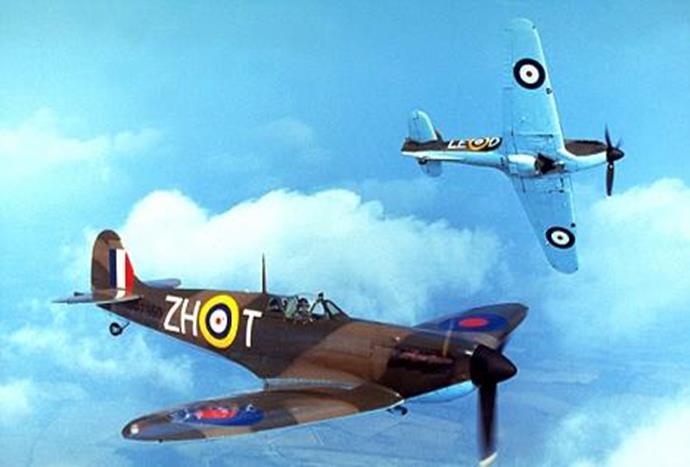

|
Data from spitfireperformance.com |
|
If the maximum speed of the Spitfire is about 400 miles per hour, then the plane’s linear speed is slower than the prop speed. This means that if the prop is in focus, then the plane certainly will be—if the photo were taken from the ground; and the top photo shows that although the prop is slightly blurred, the plane is in focus. No word on the location from where the photo was taken. Since the speed of the tip of the propeller is 9664 inch/second, the time it takes to go one inch is
Now here is where intuition comes in. We can imagine that the propeller must not move much during the time the shutter is open—if it is not to exhibit a blurred image on the film. So, how far it can move and the image not be blurry? In the photo, the far blade has moved enough to show a blur; the width of the blur seems to be less than the widest part of the blade, which is about 11”, so I estimate that the tip of the blade has traveled much less than that. Let’s say, then that about one inch is a reasonable guess for the limit of the motion for the image to remain unblurred—certainly, at least, one inch is the right order of magnitude, and since this is only an estimate anyway, it makes the calculation simple. A look at shutter speeds might indicate whether this seems reasonable. Camera shutter speeds are standardized by the various manufacturers, and are expressed in seconds, but given as a whole-number fraction. For example, a typical camera speed might be given as 1/125 seconds. This means that the shutter is open for 0.0008 seconds. Here are some standard camera speeds: |
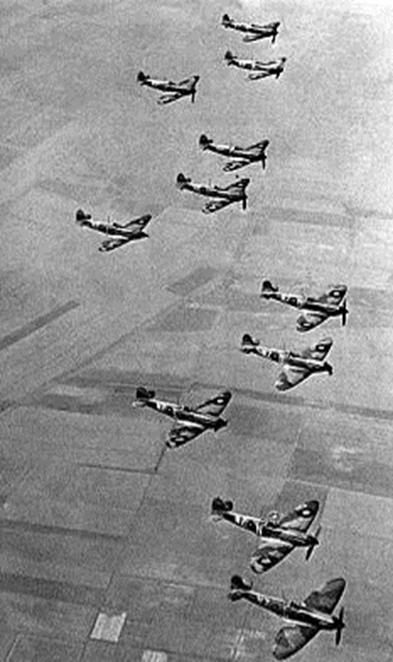
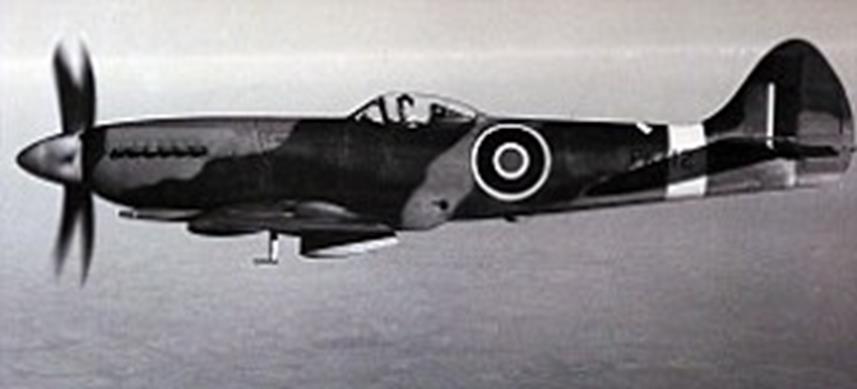
|
1 s Slow speeds are used when the blur effect is desired 1/2 s and in low light conditions. 1/4 s 1/8 s 1/15 s 1/30 s 1/60 s 1/125 s Produces sharp images of people in ordinary motion. 1/250 s 1/500 s 1/1000 s Sharp images of moderately fast motion. 1/2000 s 1/4000 s Sharp images of fast motion such as automobiles and athletes. 1/8000 s Birds and planes in flight. This is typically the maximum setting on commercially available, but relatively expensive cameras.
High speed, and high cost, cameras may have these standard settings
1/12000 s 1/16000 s Specialty equipment. Ultra-fast motion. |
|
So the time for the tip of the blade to go one inch, 1.035x10-4 s, is the maximum time the shutter would be open for this estimate of shutter speed. This time corresponds to a shutter speed of 1/9622 s. It is not unreasonable to expect a commercial photographer who is attending an air show to carry a high speed, readily available, yet not too expensive camera, say, one with a shutter speed of 1/8000 s. A reasonable agreement, I think. |
|
Take another look at the Spitfire ACS MH434, above. The blur at the end of the propeller appears to be wider than the blade at its widest point. Although the differences in timing for the adjacent shutter settings is very small, let us suppose that the photographer used a typical camera setting of 1/500 s. If so, then the shutter is open for 2.00x10–3 s. If we use the same analysis for this plane as used for the first plane, the tip of the propeller on this Spitfire would move a distance of 19 inches . Looks about right. |


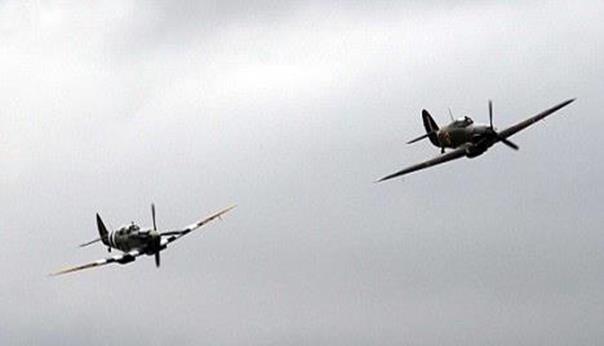




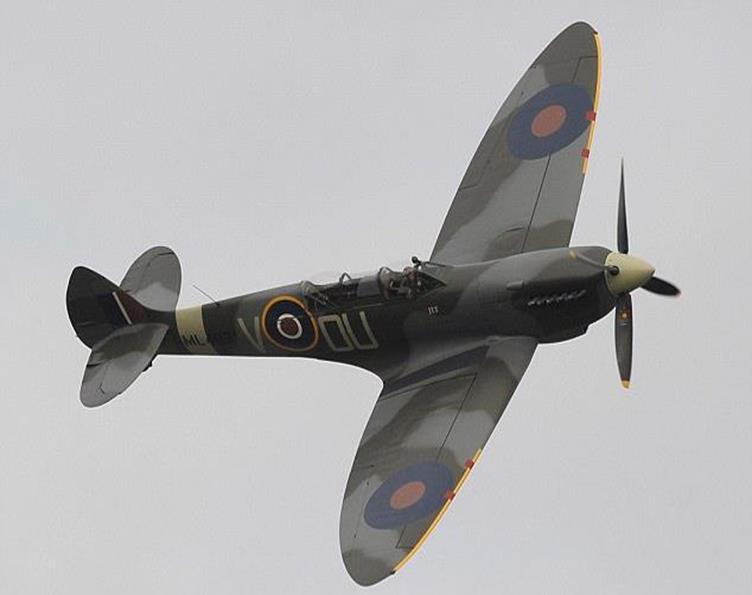
|
Spitfire Propeller Speed
The propeller in the photo almost looks as though it has stopped. The far blade is blurred, but the others are pretty clear. |
|
There is a pilot; she’s leaning forward. |
|
Note the color of the English sky. |
|
ML 407. Pilot Carolyn Grace. Flying from Southampton Airport March 5, 2011, 3:29 pm. The plane’s first flight: March 5, 1936. 3:29 pm. |
|
Markings on the plane are the same as on D-Day, when it flew over the beaches of Normandy. |
|
Rolls Royce Merlin 12 cylinder engine. The plane holds 160 gallons of fuel, with a range of 650 miles. |

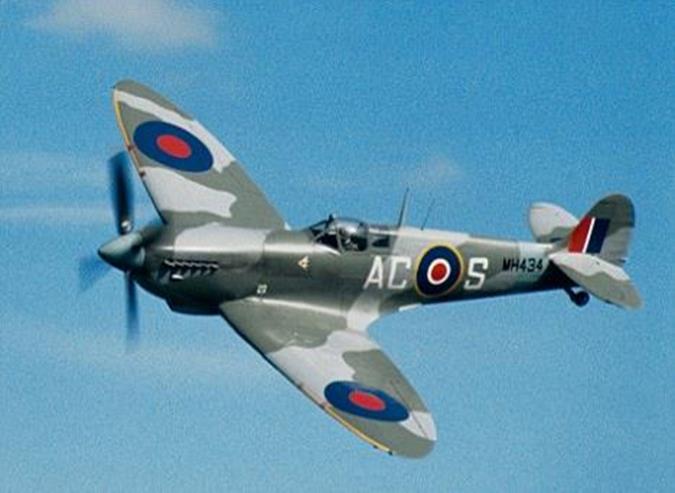
|
Notice the propeller in this picture. It is even more blurred. |
|
This picture probably was taken from another plane traveling at the same speed. This means that the camera is at rest with respect to the Spitfire. |

|
The question is not, "What is the propeller speed?", but rather, "What camera speed do you need to take a photo of an airplane with the image of the propeller unblurred?" Let's start with the airplane. Performance data for the Spitfire is below. There were numerous versions of the plane and this particular data is for some of the Mark IX planes. This was a later version, and you can see that the data is from 1943 and 1944. It was taken by the British Air Ministry to check contract compliance with the manufacturer. The data includes climb rates, top speeds - with and without bombs fitted, engine horsepower, and other interesting data. The engines were Rolls Royce Merlins, a 12-cylinder, typically with about 1500 horsepower. The plane's maximum speed was about 400 miles per hour. Climb rates were around 5000 feet per minute. If you look at the 20 March 1943 data, you will see that the "present engine rating" refers to an engine speed of 3,000 revolutions per minute. The 3 Aug 1943 data indicates that there were tests comparing combinations of gear reduction mechanisms with propeller diameters. Apparently the combination of 0.477:1 gear reduction with the 10' 9" propeller was already being produced and that the differences in performance with other combinations was too small to make any change “not appear to be worthwhile”. So we will use that. If the propeller speed is reduced from the engine speed by a ratio of 0.477:1, then
Invert this to find the time, in seconds, for the propeller to go around once:
With a propeller diameter of 10’ 9”, in one complete revolution the tip of the propeller travels
The linear speed of a point at the end of the propeller is given by distance traveled divided by elapsed time:
|
|
Aeroplane and Armament Experimental Establishment Boscombe Down 22 October 1942 Spitfire F. Mk. IX BF.274 (Merlin 61)
Climb and level speed performance
SUMMARY Climb and level speed performance has been measured on Spitfire F. Mk. IX B.F.274 both with and without a 30 gallon external jettisonable tank fitted. The climb performance at combat rating and position error have also been measured without the tank fitted. The engine was fitted with a 0.477:1 reduction gear and a Rotol R3/4F5/3 metal propeller.
Climb at normal rating: Maximum rate of climb 3200 ft.min in M.S. supercharger at 13,500 ft
Maximum rate of climb 2540 ft/min in F.S. supercharger at 25,900 ft
Service ceiling (100 ft/min) 42,100 ft
Time to 10,000 ft 3.1 min
Time to 20,000 ft 6.5 mins
Time to 30,000 ft 10.7 min
Time to 40,000 ft 20.2 min
Climb at Combat rating: Maximum rate of climb 3860 ft.min in M.S. supercharger at 12,600 ft
Maximum rate of climb 3020 ft/min in F.S. supercharger at 25,200 ft
Service ceiling (100 ft/min) 43,400 ft
Time to 10,000 ft 2.7 min
Time to 20,000 ft 5.6 min
Time to 30,000 ft 9.2 min
Time to 40,000 ft 16.6 min
Level Speeds: Maximum true air speed 380 1/2 m.p.h. in M.S. supercharger at 15,400 ft
Maximum true air speed 403 m.p.h. in F.S. supercharger at 27,400 ft
Without 30 gallon tank |
|
Aeroplane and Armament Experimental Establishment Boscombe Down 17 March 1943 Spitfire F. Mk. IX BS.428 (Merlin 61)
Level speed performance with and without a 500 lb bomb fitted Condition Max. True Air Speed Full Throttle Height m. p. h feet _________
With one 500 lb. bomb fitted 363 14,500
With external bomb installations 385 14,750 removed
SUMMARY Level speed measurements have been carried out on this aircraft to assess the effect of fitting a 500 lb bomb on an unfaired rack beneath the fuselage. The installaton was one designed and fitted by Fighter Command personnel. Level speed performance was measured between 11,000 ft. and 21,000 ft. using all-out level power conditions in M.S. supercharger gear with the radiator flaps closed.
Conclusions The reduction in maximum true air speed in M.S. supercharger gear due to fitting a 500 lb. bomb and a bomb rack without fairing is 22 m.p.h. |

|
Aeroplane and Armament Experimental Establishment
Spitfire HF. Mk. IX EN.524
SUMMARY ..................Comparitive performance trials have been carried out on Spitfire HF. Mk. IX EN.524 with the following combinations of propeller and reduction gear:
(i) 0:477:1 reduction gear 10'9" diameter 4 blade propeller (ii) 0:42:1 reduction gear 10'9" diameter 4 blade propeller (iii) 0:42:1 reduction gear 11'1" diameter 4 blade propeller
0:477:1 reduction gear 10'9" diameter propeller results |
|
Aeroplane and Armament Experimental Establishment
Spitfire HF. Mk. IX BS.310
SUMMARY
..................Compartive climb and level speed performance trials have been made on Spitfire HF. Mk. IX BS.310 with a 0.477:1 reduction gear and a 4 blade propeller, and with a 0.42:1 reduction gear and a 5 blade propeller. |
|
Rolls-Royce, Ltd
Spitfire J.L. with Merlin 66 at 25 lbs. Boost Pressure
Climb performance
Improvement over climb at Altitude Rate of climb +18 lb. boost ft ft/min ft/min_______________ 0 5740 780 5,000 5080 110 10,000 5080 800 15,000 4470 190 20,000 3720 — 25,000 2950 — 30,000 2200 —
Level speed performance
Altitude + 18 lb boost + 25 lb boost Increase ft ______________________ 0 330 M.S. 354 M.S. +24 m.p.h. 3,200 343 M.S. 367 M.S. (a) +24 m.p.h. 8,000 364 M.S. 367 M.S. +3 m.p.h. 10,000 367 M.S. 377 F.S. +10 m.p.h. 14,400 373 F. S. 379 (a) +24 m.p.h. 20,000 397 (a) 397 — 25,000 394 (a) 394 — (a) Full Throttle Height |
|
Aeroplane and Armament Experimental Establishment
Spitfire F. Mk. IX BS.543 Spitfire F. Mk. IX BS.551 (Merlin 61) (Merlin 70)
SUMMARY Two low altitude versions of the intercooled Merlin engine were made which were designated the RM-9SM and RM-10 SM. In addition an improved type of high altitude engine designated the RM-11 SM was made. The RM-10 SM and the RM-11 SM were subsequently given mark numbers and are now known as the Merlin 66 and Merlin 70 respectively. |
|
Aircraft Data Aircraft Engine Engine Power Max. Speed Weight Service Ceiling B.H.P. lb. at mean weight
Spitfire F IX Merlin 63 1,710 @ 8,500 ft 382 m.p.h @ 12,500 ft M.S. 7,450 44,000 ft 1,520 @ 21,000 ft 408 m.p.h @ 25,000 ft F.S.
Spitfire LF IX Merlin 66 1,720 @ 5,750 ft 384 m.p.h @ 10,500 ft M.S. 7,450 42,500 ft 1,595 @ 16,000 ft 404 m.p.h @ 21,000 ft F.S.
Spitfire HF IX Merlin 70 1,710 @ 11,000 ft 396 m.p.h @ 15,000 ft M.S. 7,450 45,000 ft 1,475 @ 23,250 ft 416 m.p.h. @ 27,500 ft F.S. |
|
Climb at combat rating. 4 blade propeller Max. rate of climb at full throttle height 4470 ft/min in M.S. supercharger gear at 11,200 ft Max. rate of climb at full throttle height 3400 ft/min in F.S. supercharger gear at 22,700 ft Time to 5,000 ft 1.15 min Time to 11,200 ft (M.S. gear F.T. height) 2.55 min Time to 15,000 ft 3.5 min Time to 22,700 ft (F.S. gear F.T. height) 5.65 min Time to 25,000 6.4 min Time to 35,000 11.05 min Time to 40,000 16.25 min Estimated service ceiling 43,100 ft |
|
Level speed performance. Max. level speed at full throttle height 388 m.p.h. in M.S. gear at 14,600 ft Max. level speed at full throttle 405 m.p.h. in F.S. gear at 25,400 ft 5 blade propeller results omitted |
|
Conclusion The performance of the aircraft is similar with either propeller-reduction gear combination and no particular advantage in performance would be obtained by replacing the 4 blade propeller by a 5 blade propeller. |
|
It was stated (in the above report) that further tests were to be carried out with a modified carburettor setting as it was hoped to improve the performance of the Merlin 70 at altitude. It is understood that EN.524 incorporated this modification and a comparison of the two sets of results shows a considerable improvement has been made. The absolute ceiling is now about 2,500 feet higher than that obtained on BS.551.
Conclusion The combination giving the best compromise between climb and level speed performance appears to be the 10'9" diameter propeller with 0.477:1 reduction gear up to about 28,000 feet. Above this height the best combination appears to be the 11'1" propeller with 0.42:1 reduction gear. However, the differences as a whole are so small that a change from any combination already produced and in Service (0.477:1/10'9") would not appear to be worthwhile. |
|
Level Speeds
Height TAS m.p.h.
Sea level 326 7,000 ft 358 15,100 ft 394 (M.S. gear F.T. height) 26,600 ft 413 (F.S. gear F.T. height) 30,000 ft 407 39,000 ft 369
Results of the other combinations omitted |
|
Climbs
Height Rate of climb Time ft/min min
10,000 ft 4310 2.3 11,300 ft 4310 2.6 (M.S. s/c gear F.T. height) 20,000 ft 3220 5.0 23,900 ft 3220 6.2 (F.S. s/c gear F.T. height) 30,000 ft 2275 8.4 40,000 ft 65 16 |
|
Note: BS.543 was built as a Mk V, converted to Mk IX (Merlin 61) at Rolls Royce, Hucknall. First flight 22-10-42. Transferred to AFDU, Duxford 8-11-42; AAEE, Boscombe Down 13-12-42 with Merlin 66 installed; Vickers Armstrong 22-2-43; 403 Sqdn. 9-6-43; 611 Sqdn. 10-6-43; 485 Sqdn. 6-7-43. Failed to return from operations 22-8-43.
BS.551 was built as a Mk V, converted to Mk IX (Merlin 61) at Rolls Royce, Hucknall. First flight 31-10-42. Merlin 70 installed by Rolls Royce, Hucknall 1-11-42. Flying accident, category E 4-1-43. |
|
Level speeds
Maximum level speed at sea level 336 m.p.h 329 m.p.h.
Maximum level speed at M.S. gear 384 m.p.h. 396 m.p.h. full throttle height at 10,800 ft at 15,900 ft
Maximum level speed at F.S. gear 407 m.p.h. 415.5 m.p.h. full throttle height at 22,000 ft at 27,800 ft
Level speed at 30,000 ft 395 m.p.h. 413 m.p.h.
Level speeds corrected to 18.0 lb/sq.in. boost RM-9SM engined Spitfire omitted. |
|
Climbs
Condition Spitfire IX Spitfire IX BS. 543 BS. 551 Merlin 66 Merlin 70
Rate of climb at sea level 4620 ft/min 4390 ft/min
Rate of climb at full throttle height 4700 ft/min 4530 ft/min in M.S. supercharger gear at 7000 ft at 11,900 ft
Rate of climb at full throttle height 3860 ft/nub 3480 ft/min in F.S. supercharger gear at 18,000 ft at 24,700 ft
Rate of climb at 30,000 ft 2125 ft/min 2600 ft/min
Time to 10,000 ft 2.15 min 2.25 min
Time to 20,000 ft 4.75 min 4.85 min
Time to 30,000 ft 8.4 min 8.05 min
Height at which rate of climb is 37,100 ft 38,000 ft 1000 ft/min
Time to reach above height 12.9 min 12.6 min
Service ceiling (1000 ft/min) 40,9000 ft 41,000 ft
Estimated absolute ceiling 41,300 ft 41,300 ft
Rate of climb corrected to 18.0 lb/sq.in. boost. |